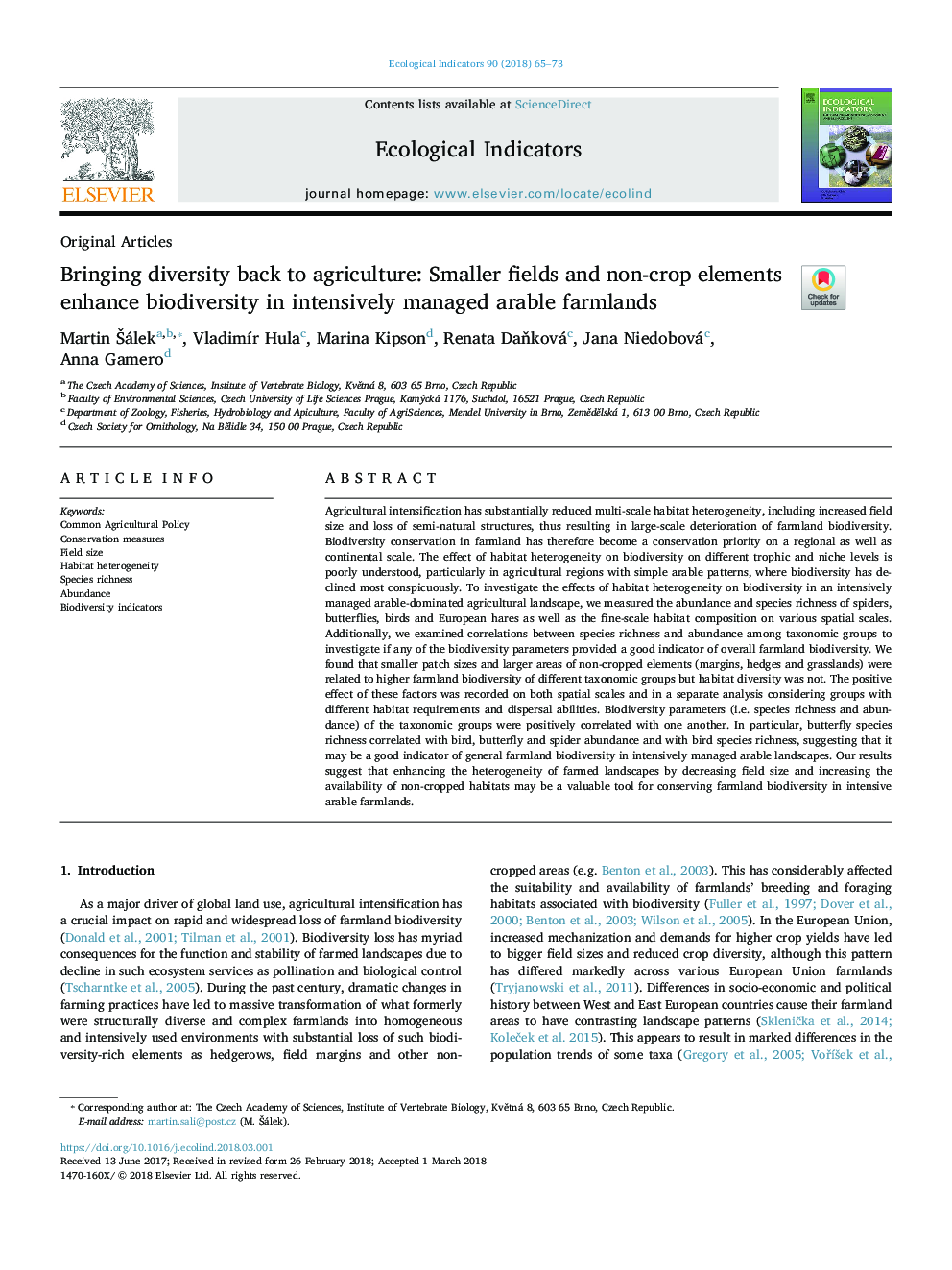| کد مقاله | کد نشریه | سال انتشار | مقاله انگلیسی | نسخه تمام متن |
|---|---|---|---|---|
| 8845347 | 1617112 | 2018 | 9 صفحه PDF | دانلود رایگان |
عنوان انگلیسی مقاله ISI
Bringing diversity back to agriculture: Smaller fields and non-crop elements enhance biodiversity in intensively managed arable farmlands
ترجمه فارسی عنوان
تنوع زیستی به کشاورزی: مزارع کوچک و عناصر غیر زراعتی باعث افزایش تنوع زیستی در زمین های کشاورزی مرتفع می شود
دانلود مقاله + سفارش ترجمه
دانلود مقاله ISI انگلیسی
رایگان برای ایرانیان
کلمات کلیدی
سیاست مشترک کشاورزی، اقدامات حفاظتی، اندازه میدان، ناهمگونی محل زندگی، غنای گونه، فراوانی، شاخص های تنوع زیستی،
ترجمه چکیده
تشدید کشاورزی به طور قابل ملاحظه ای ناهمگونی چندگانه زیستگاه را کاهش داده است، از جمله افزایش اندازه میدان و از دست دادن ساختارهای نیمه طبیعی، و در نتیجه موجب وخامت زیادی در تنوع زیستی زمین های کشاورزی می شود. حفاظت از تنوع زیستی در زمین های کشاورزی به همین دلیل تبدیل به یک اولویت حفاظت در مقیاس منطقه ای و همچنین قاره شده است. اثر ناهمگونی زیستگاه بر تنوع زیستی در سطوح مختلف طغیان و طاقچه به ویژه در مناطق کشاورزی با الگوهای ساده زراعی، که تنوع زیستی آن بیشتر قابل توجه است، درک نمی شود. به منظور بررسی تأثیر ناهمگونی زیستگاه بر تنوع زیستی در یک چشم انداز کشاورزی تحت کنترل شدید کشاورزی، میزان غنای فراوان و گونه های عنکبوت، پروانه ها، پرندگان و خرگوش اروپایی و همچنین ترکیب زیستگاه در مقیاس های مختلف فضایی اندازه گیری شد. علاوه بر این، ما بررسی رابطه بین غنای گونه و فراوانی در میان گروه های طبقه بندی برای بررسی اگر هر یک از پارامترهای تنوع زیستی نشان می دهد شاخص های کل تنوع زیستی در کل زمین های کشاورزی. ما دریافتیم که اندازه های کوچکتر و مناطق بزرگتر از عناصر غیر برداشت شده (حاشیه، حجاب و چمن زنی) به تنوع زیستی زراعتی بیشتر از گروه های مختلف طبقه بندی مربوط بود، اما تنوع زیستگاه ها در آن نبود. اثرات مثبت این عوامل در هر دو مقیاس فضایی و در تجزیه و تحلیل جداگانه با توجه به گروه های مختلف با نیازهای زیست محیطی و توانایی های پراکندگی ثبت شد. پارامترهای تنوع زیستی (به عنوان مثال غنای گونه و فراوانی) گروه های طبقه بندی با یکدیگر رابطه مثبت داشتند. به طور خاص، غنای گونه پروانه با وجود فراوانی پرنده، پروانه و عنکبوت و غنای گونه های پرنده ارتباط دارد، که نشان می دهد که این می تواند شاخصی برای تنوع زیستی گیاهان زراعی باشد که در پرورش منظرهای قابل کاشت به کار برده می شود. نتایج ما نشان می دهد که افزایش ناهمگونی مناظر مزرعه با کاهش اندازه قلمرو و افزایش دسترسی به زیستگاه های غیر زراعی ممکن است یک ابزار ارزشمند برای حفاظت از تنوع زیستی زمین های کشاورزی در زمین های زراعی آبی است.
موضوعات مرتبط
علوم زیستی و بیوفناوری
علوم کشاورزی و بیولوژیک
بوم شناسی، تکامل، رفتار و سامانه شناسی
چکیده انگلیسی
Agricultural intensification has substantially reduced multi-scale habitat heterogeneity, including increased field size and loss of semi-natural structures, thus resulting in large-scale deterioration of farmland biodiversity. Biodiversity conservation in farmland has therefore become a conservation priority on a regional as well as continental scale. The effect of habitat heterogeneity on biodiversity on different trophic and niche levels is poorly understood, particularly in agricultural regions with simple arable patterns, where biodiversity has declined most conspicuously. To investigate the effects of habitat heterogeneity on biodiversity in an intensively managed arable-dominated agricultural landscape, we measured the abundance and species richness of spiders, butterflies, birds and European hares as well as the fine-scale habitat composition on various spatial scales. Additionally, we examined correlations between species richness and abundance among taxonomic groups to investigate if any of the biodiversity parameters provided a good indicator of overall farmland biodiversity. We found that smaller patch sizes and larger areas of non-cropped elements (margins, hedges and grasslands) were related to higher farmland biodiversity of different taxonomic groups but habitat diversity was not. The positive effect of these factors was recorded on both spatial scales and in a separate analysis considering groups with different habitat requirements and dispersal abilities. Biodiversity parameters (i.e. species richness and abundance) of the taxonomic groups were positively correlated with one another. In particular, butterfly species richness correlated with bird, butterfly and spider abundance and with bird species richness, suggesting that it may be a good indicator of general farmland biodiversity in intensively managed arable landscapes. Our results suggest that enhancing the heterogeneity of farmed landscapes by decreasing field size and increasing the availability of non-cropped habitats may be a valuable tool for conserving farmland biodiversity in intensive arable farmlands.
ناشر
Database: Elsevier - ScienceDirect (ساینس دایرکت)
Journal: Ecological Indicators - Volume 90, July 2018, Pages 65-73
Journal: Ecological Indicators - Volume 90, July 2018, Pages 65-73
نویسندگان
Martin Å álek, VladimÃr Hula, Marina Kipson, Renata DaÅková, Jana Niedobová, Anna Gamero,
